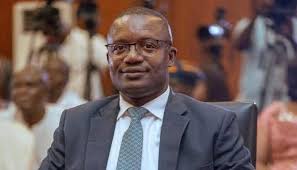Energy Minister Highlights Major Gains and Reforms in Power Sector Stabilisation and Green Transition Agenda in First Half of 2025
Minister for Energy and Green Transition, John Jinapor, has outlined key achievements and strategic reforms undertaken within Ghana’s energy sector since January 2025, aimed at stabilising power supply, boosting upstream petroleum activity, and transitioning to a green and sustainable energy economy.
Delivering an extensive address at the Government Accountability Series on Wednesday, July 16, 2025, Mr Jinapor noted that the government inherited a severely distressed sector plagued by underinvestment, debt accumulation, supply deficits and regulatory uncertainty.
“Ghana’s energy sector was on the brink of collapse. We were confronted with over US$1.7 billion owed to Independent Power Producers (IPPs), total purchase debt of US$3.1 billion and an overall sector debt exceeding GHS 80 billion,” he stated.
The Minister revealed that in December 2024, the country’s power supply deficit peaked at 720MW, while fuel stock levels dropped to record lows. IPPs continuously threatened to shut down operations over unpaid generation bills.
In the petroleum sector, crude oil production plunged from 71.44 million barrels in 2019 to 48.25 million barrels in 2024 due to declining investments and a poisoned business environment.
Green Transition and Renewable Energy Push
Amidst these setbacks, the Minister announced that the government has since embarked on an ambitious green transition programme. Key initiatives include the launch of the Ghana Scaling-up Renewable Energy Program (SREP), funded with $85 million from the AfDB, CIF, SECO and GoG. The programme targets:
Deployment of 12,000 net-metered solar PV systems
Construction of 35 mini-grids to electrify 47 island communities
Provision of 1,450 solar home systems for remote off-grid areas
Other interventions include:
Development of 200MW of solar energy projects and floating solar plants at Bui and Kpong hydropower stations
Establishment of a Renewable Energy Authority and a Renewable Energy and Green Transition Fund
Installation of 23,500 solar streetlights covering over 700km of road networks
Deployment of 22MW of solar power under the Government Goes Solar project, expected to save GHS 52 million annually
Advancement of Ghana’s nuclear power ambitions to Phase 2 of the IAEA Milestone Approach
Electric vehicle pilot initiatives, including a solar charging facility at the Energy Commission
Ghana is also set to host the 7th Africa Regional Committee Meeting of the International Solar Alliance (ISA) in September 2025, where Minister Jinapor serves as Vice President.
Power Sector Stabilisation and Infrastructure Reforms
The Minister detailed reforms that have seen a notable improvement in power reliability across the country. Highlights include:
A Distribution Network Improvement Programme that patrols and rectifies faults across ECG feeders
Termination of 202 non-performing ECG contracts worth over $227 million, £1.17 million and €4.08 million
Implementation of the new Zeus billing system within three months
Full compliance with the Cash Waterfall Mechanism, ensuring timely payments to power producers and fuel suppliers
ECG’s highest-ever revenue in June 2025, at GHS1.678 billion – a 47.3% YoY increase
Connection of 63 new communities to the national grid under the Rural Electrification Programme
Cabinet approval for private sector participation (PSP) in electricity distribution via a multiple lease model
Additionally, steps have been taken to secure consistent gas supply, including increased deliveries from N-Gas, ENI, and Jubilee fields.
Petroleum Sector Recovery
The Minister reported renewed interest in Ghana’s upstream petroleum sector, attributed to policy clarity and investor engagement. Key milestones include:
Declaration of commerciality for the Afina and Eban-Akoma discoveries, set to boost hydrocarbon production
US$2 billion investment commitment secured for Jubilee and TEN fields to drill 20 new wells
A cost audit that identified potential savings of US$228 million
Increased balances in the Local Content Fund, reaching GHS 29.89 million and US$2.49 million respectively
Efforts to resolve legacy disputes, including the ENI-Springfield impasse and fiscal regime reforms, are ongoing to restore investor confidence.
Downstream Petroleum and TOR Revamp
Mr Jinapor also disclosed efforts to resuscitate the Tema Oil Refinery (TOR), which had been idle for years and burdened by a $517 million debt. Turnaround maintenance works are underway, with operations expected to restart in October 2025 using internally generated funds and ESLA-backed support.
Other downstream efforts include:
Finalisation of the Second Gas Processing Plant (GPP II) implementation report
Funding arrangements for retooling Ghana Cylinder Manufacturing Company (GCMC)
Completion of a comprehensive downstream sector reform report, with a new NPA Bill expected to be tabled in Parliament
Looking Ahead
Concluding his presentation, the Energy Minister expressed optimism about the future of Ghana’s energy sector, citing government’s resolve to build a resilient, efficient and green energy architecture.
“We have stabilised power supply, enhanced petroleum reserves, and instituted deep-rooted reforms. Our path to a greener, sustainable and energy-secure Ghana is firmly underway,” he stated.








